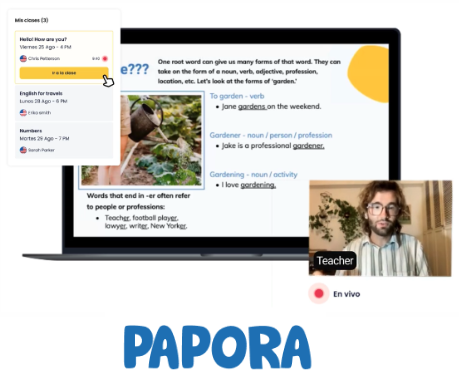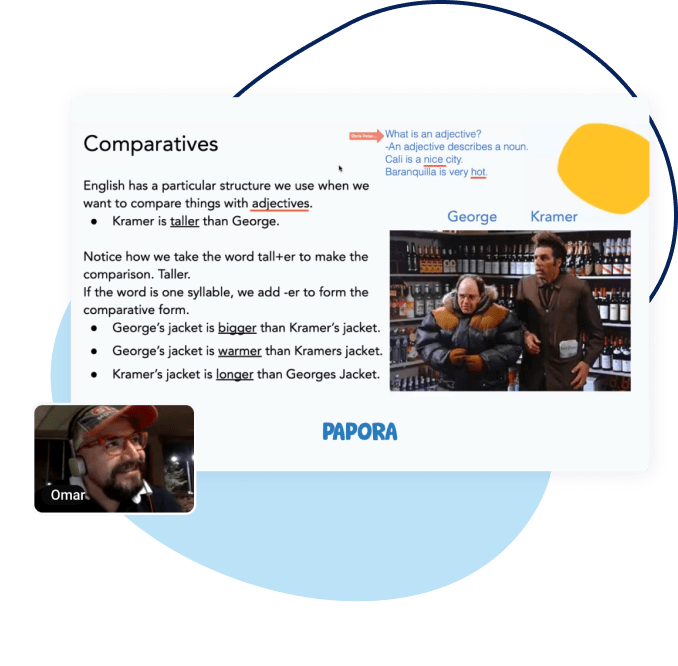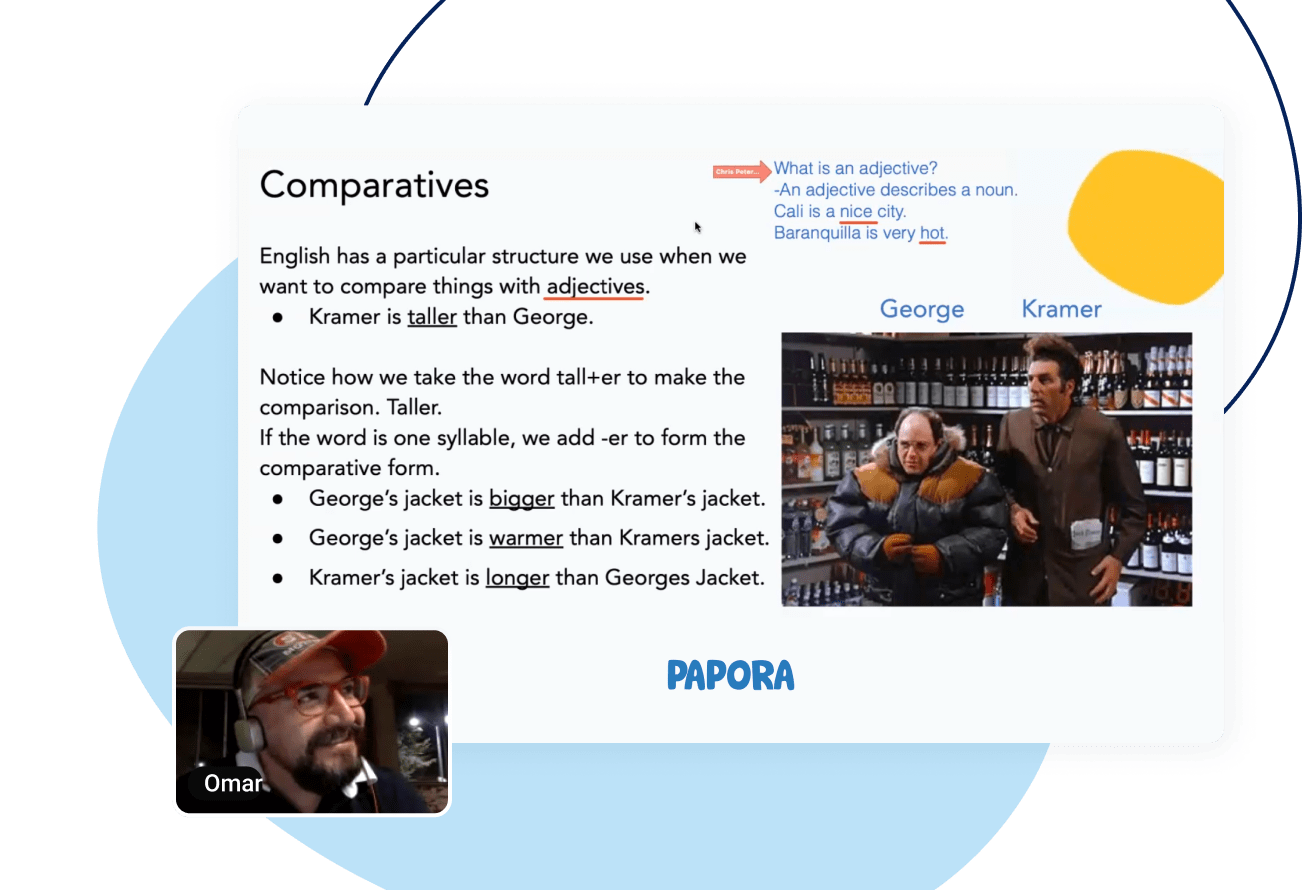Los adjetivos en inglés juegan un papel crucial al agregar detalles y matices a nuestras descripciones. Son esenciales para comunicar de manera efectiva y enriquecer nuestras conversaciones.
En este artículo, exploraremos cómo se utilizan los adjetivos en inglés, sus diferencias con el español y cómo puedes mejorar tu vocabulario con ejemplos prácticos. ¡Let’s start!
¿Qué son los adjetivos en inglés?
Los adjetivos son las palabras descriptivas, añaden detalles y características a personas, lugares o cosas, haciendo nuestras descripciones más precisas.
Cuando decimos que una amiga es baja, alegre, graciosa, artística y colombiana, estamos empleando adjetivos.
Si describimos a Lima como una ciudad enorme, caótica, diversa e internacional, también estamos usando adjetivos para resaltar sus cualidades. Del mismo modo, al decir que una olla es pesada, vieja y fiable, estamos utilizando adjetivos para definir sus características.
En inglés, el uso de los adjetivos es esencial para alcanzar la fluidez en el idioma, ya sea al hablar, escribir, escuchar y leer.
Si te interesa aprender sobre más temas en inglés puedes leer las guías sobre el pasado simple y pasado continuo, adverbios en ingles y los pronombres personales en ingles.
Los adjetivos describen los sustantivos/nombres
Para entender bien lo que es un adjetivo, primero tenemos que entender lo que es un sustantivo o nombre.
Los sustantivos son personas, lugares, y cosas.
- Shakira es un sustantivo, ya que es una persona.
- Lima, Perú, es un sustantivo porque es un lugar.
- Una olla es un sustantivo porque es una cosa.
También ideas y conceptos como la democracia y el amor son sustantivos, pero por ahora nos enfocamos en las personas, sitios, y cosas.
Clasificación de los Adjetivos en Inglés
Los adjetivos sirven para describir en sustantivos en inglés, añadiendo características que nos permiten entender mejor cómo son.
- The house is red. - La casa es roja.
- En este ejemplo, “red” es el adjetivo que describe el sustantivo, la “house”.
- El Salvador is a beautiful country. - El Salvador es un país hermoso.
- aquí, el adjetivo “beautiful” describe el sustantivo, “El Salvador”.
Mide tu nivel de inglés con el test de Papora
Con nuestro test, podrás conocer tu nivel en tan solo unos minutos. Tendrás una evaluación que te permitirá enfocarte en lo que realmente necesitas mejorar.
Haz la prueba

¿Cómo se usan los adjetivos en inglés?: Reglas
Hay tres estructuras principales que podemos usar para describir un sustantivo con un adjetivo.
To be + adjetivo
Con esta estructura, identificamos el sujeto y usamos el verbo “to be” más un adjetivo para describirlo.
- Sam is short. - Sam es bajo.
- The store is closed. - La tienda está cerrada.
- My aunts and uncles are crazy. - Mis tías y tíos son locos.
Adjetivo + sustantivo
A diferencia del español, donde los adjetivos se colocan después del sustantivo, en inglés el adjetivo va antes del sustantivo que describe.
- Mark is a tall man. - Mark es un hombre alto.
- They live in a big house. - Ellos viven en una casa grande.
- We have an expensive TV. - Tenemos un televisor caro.
Otro verbo + adjetivo
También podemos combinar un verbo con un adjetivo.
- She feels tired today. - Ella se siente cansada hoy.
- We will stay awake until late. - Vamos a quedarnos despiertos hasta tarde.
- My dad is getting old. - Mi papá está envejeciendo.
Diferencias entre español y ingles
Hay dos diferencias principales en cómo tratamos los adjetivos en inglés y en español.
La primera diferencia se refiere a la posición del adjetivo. En español, el adjetivo va después del sustantivo, en inglés, ocurre al revés: el sustantivo sigue al adjetivo.
Por ejemplo:
- He is a tall boy. - Él es un chico alto
- They have a broken computer. - Tienen una computadora rota.
- She drives a beautiful car. - Ella maneja un auto hermoso.
La segunda diferencia es que los adjetivos en inglés no cambian por género ni cantidad, a diferencia del español, donde se modifican según el sustantivo. En inglés, el adjetivo siempre permanece igual:
- The tall boy. - El chico alto.
- The tall girl. - La chica alta.
- The tall boys. - Los chicos altos.
- The tall girls. - Las chicas altas.
Aprende inglés fácilmente junto a los profesores de Papora
Descubre cómo Papora puede ayudarte a usar los adjetivos en inglés con confianza. Clases en grupo con profesores expertos.
Regístrate ahora

101 adjetivos comunes en Inglés
Aquí tienes una lista con 101 adjetivos en inglés que son usados con frecuencia en conversaciones y que te ayudarán a ampliar tu vocabulario.
| English | Español | Ejemplo |
| Happy | Feliz | She feels happy today. |
| Sad | Triste | He looks sad after the news. |
| Angry | Enojado | I was angry about the situation. |
| Excited | Emocionado | The kids were excited for the trip. |
| Calm | Tranquilo | She remained calm during the storm. |
| Brave | Valiente | The firefighter was brave. |
| Shy | Tímido | He's too shy to speak in public. |
| Funny | Gracioso | The comedian was really funny. |
| Bored | Aburrido | I am bored with this movie. |
| Nervous | Nervioso | She felt nervous before the exam. |
| Friendly | Amigable | The dog was very friendly. |
| Tall | Alto | He is a tall man. |
| Short | Bajo | She is shorter than her brother. |
| Strong | Fuerte | He is very strong. |
| Weak | Débil | She felt weak after the workout. |
| Heavy | Pesado | The box is heavy. |
| Light | Ligero | This bag is light. |
| Rich | Rico | He became rich through hard work. |
| Poor | Pobre | Many people in the village are poor. |
| Clean | Limpio | The room is clean now. |
| Dirty | Sucio | The floor is dirty. |
| Fast | Rápido | The car is very fast. |
| Slow | Lento | The internet connection is slow. |
| Old | Viejo | This is an old building. |
| New | Nuevo | I bought a new phone. |
| Hot | Caliente | The coffee is hot. |
| Cold | Frío | The water is cold. |
| Hard | Duro | This mattress is too hard. |
| Soft | Suave | The pillow is soft. |
| Empty | Vacío | The bottle is empty. |
| Full | Lleno | The room is full of people. |
| Bright | Brillante | The sun is very bright today. |
| Dark | Oscuro | The room is too dark to read. |
| Expensive | Caro | This watch is expensive. |
| Cheap | Barato | I found a cheap flight to Paris. |
| Deep | Profundo | The lake is very deep. |
| Shallow | Poco profundo | The pool is shallow on this side. |
| Long | Largo | This road is very long. |
| Popular | Popular | This is a very popular band. |
| Quiet | Silencioso | The library is a quiet place. |
| Loud | Ruidoso | The music is too loud. |
| Tasty | Sabroso | The food was very tasty. |
| Sour | Agrio | The lemon tastes sour. |
| Bitter | Amargo | The coffee is too bitter. |
| Sweet | Dulce | The cake is sweet. |
| Salty | Salado | The soup is too salty. |
| Hungry | Hambriento | I am hungry right now. |
| Thirsty | Sediento | He was thirsty after running. |
| Hardworking | Trabajador | She is a hardworking student. |
| Lazy | Perezoso | He was too lazy to finish the project. |
| Famous | Famoso | The singer is famous worldwide. |
| Unknown | Desconocido | The artist remained unknown for many years. |
| Real | Real | The threat was real. |
| Fake | Falso | The document turned out to be fake. |
| Alive | Vivo | The patient is still alive. |
| Dead | Muerto | The fish was dead when they found it. |
| Healthy | Saludable | A healthy lifestyle is important. |
| Sick | Enfermo | She stayed home because she was sick. |
| Open | Abierto | The store is open all day. |
| Closed | Cerrado | The museum is closed on Mondays. |
| Kind | Amable | She was very kind to me. |
| Mean | Malo | He was being mean to his classmates. |
| Polite | Educado | He was polite to everyone. |
| Rude | Grosero | The waiter was rude. |
| Lucky | Suertudo | She is lucky to have found a job. |
| Unlucky | Desafortunado | He was unlucky in the lottery. |
| Smart | Inteligente | She is very smart. |
| Silly | Tonto | Don’t be silly. |
| Busy | Ocupado | He is busy with work. |
| Free | Libre | I am free this afternoon. |
| Safe | Seguro | This neighborhood is safe. |
| Dangerous | Peligroso | The streets are dangerous at night. |
| Early | Temprano | She arrived early to the meeting. |
| Late | Tarde | He was late to the party. |
| Big | Grande | The house is big. |
| Small | Pequeño | The room is small. |
| Religious | Religioso | My grandfather is very religious. |
| Simple | Simple | I like simple food. |
| Fresh | Fresco | The bread is fresh. |
| Stale | Rancio | The bread is stale. |
| Tired | Cansado | He felt tired after the long walk. |
| Beautiful | Hermoso | The view is beautiful. |
| Ugly | Feo | The old building looks ugly. |
| Gentle | Suave | She has a gentle touch. |
| Rough | Áspero | The surface is rough. |
| Warm | Cálido | The blanket is warm. |
| Cool | Fresco | The evening is cool. |
| Wide | Ancho | The river is wide here. |
| Narrow | Estrecho | The path is narrow. |
| Thick | Grueso | The book is thick. |
| Thin | Delgado | The paper is thin. |
| Smooth | Suave | The glass is smooth. |
| Ready | Listo | Are you ready? |
| Serious | Serio | This is a very serious matter. |
| Foreign | Extranjero | He lives in a foreign country. |
| Private | Privado | I prefer to fly in a private plane. |
| Easy | Fácil | Chess is not an easy game. |
| International | Internacional | This is an international flight. |
| Public | Público | This isn't public information. |
| Red | Rojo | The firetruck is red. |
| Different | Diferente | I have a different idea. |
Ejercicios
Usa la lista de arriba para encontrar la traducción de estos adjetivos comunes y terminar las oraciones.
- She has a very _______ cat. (hambriento)
- The movie was really _______. (aburrido)
- My brother is very _______. (alto)
- This is an _______ book. (viejo)
- They live in a _______ house. (pequeño)
- My teacher is always _______. (amable)
- The weather today is _______. (frío)
- We visited an _______ city last summer. (caro)
- This soup is too _______. (caliente)
- I bought a _______ car last week. (nuevo)
El mejor consejo: Aprende inglés con Papora
Para llevar tu uso de los adjetivos en inglés al siguiente nivel, Papora es la opción ideal. Aprenderás con profesores expertos en clases en vivo, adaptadas a tus necesidades.
En nuestra plataforma online, tendrás acceso a clases ilimitadas al mes, con videollamadas y grupos reducidos para un aprendizaje más personalizado. Así, podrás mejorar tu habilidad para usar adjetivos y avanzar en otras áreas del inglés.
Además, contamos con un curso autodidacta con más de 100 lecciones interactivas, para que puedas practicar y consolidar tus conocimientos a tu ritmo. ¡Empieza hoy y disfruta aprendiendo con Papora!
1) hungry 2) boring 3) tall 4) old 5) small 6) kind 7) cold 8) expensive 9) hot 10) new.
Habla inglés desde la primera clase con Papora
Papora te ofrece la oportunidad de empezar a hablar inglés desde el primer día. Clases en vivo adaptadas a tu ritmo.
¡Empieza ahora!

Preguntas frecuentes sobre adjetivos en inglés
Sí, existe una amplia variedad de adjetivos en inglés, como comparativos (taller…), superlativos en inglés (tallest…), adjetivos posesivos (my, your…), demostrativos (this, that…), de cantidad (few, many…), y numéricos (one, two…), los cuales serán ampliados en futuros artículos.
Para expandir tu vocabulario, es importante interactuar con el idioma de forma holística, leyendo textos completos y escuchando audios. De ahí, identifica las nuevas palabras y anótalas. Es mejor aprender nuevas palabras, así que solo memorizar listas eternas de vocabulario.




